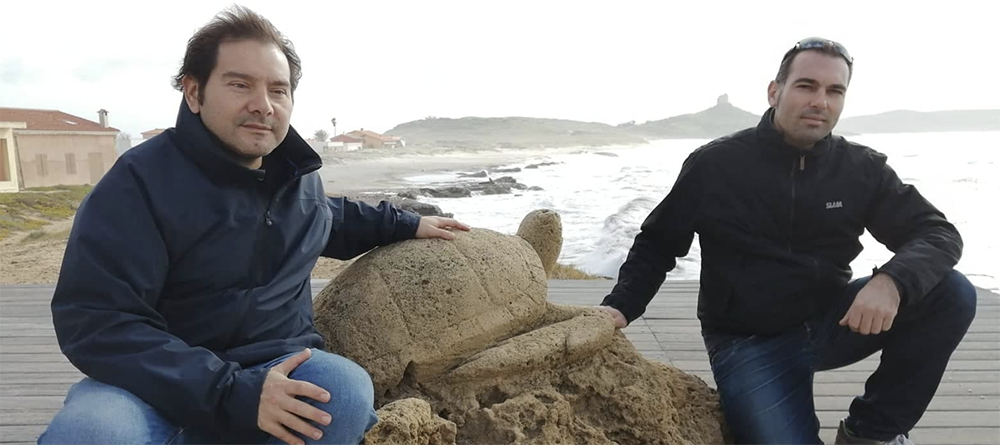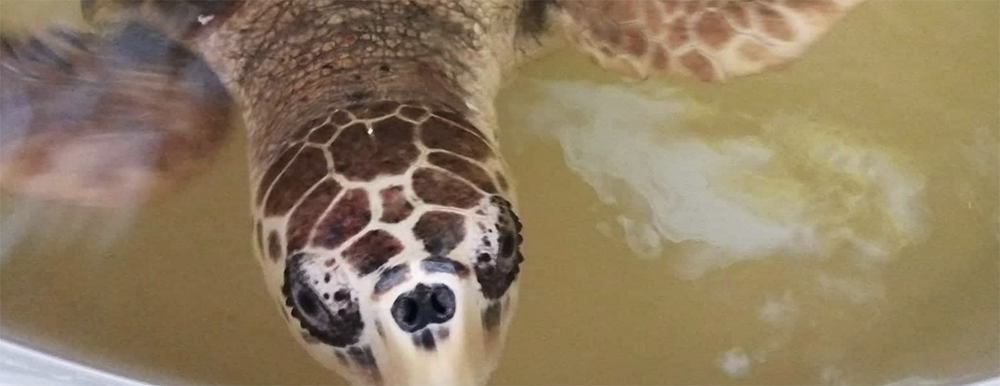With her fins "Crash" touches the walls of the tank, as if she wanted to climb. She floats with a small acute angle in the surface. It will take a little more time to completely recover your balance. Then she dives, reaching the sardine on the bottom, and makes it disappear between the jaws, generating an ephemeral dark spot in the water.
"We called him Crash because she arrived here after an unfortunate clash with the propeller of a boat, which broke the carapace", recollects Andrea Camedda, CNR marine biologist and one of the researchers involved in the activities of the CRES, the Sinis Recovery Center. Thanks to a proven relay from the protected Marina of Tavolara, Crash was moved here, among the rooms overlooking the magical and slender arch of the peninsula, today beaten by a rushing west wind that lifts and pushes the waves onto the cliffs.
“We welcome turtles from all marine protected areas of Sardinia. CRES is one of the places I like to call ‘widespread clinic’. All institutions collaborate in the tratment, theNational Research Center, the Marine Protected Area, the Duemari clinic of Oristano, where the caretta caretta are visited in the first instance. We are the only center in the Mediterranean to submit them to the CAT scan", explains Andrea De Lucia, marine biologist specializing in conservation and protected species, and in charge of the CRES.
Crash is in the company of Genoveffa, Gavino and Freezer, a freshwater alligator turtle. Genoveffa and Gavino suffer from a metabolic dysfunction that undermines the entire bone structure. The carapace’s pigmentation shows that healing is still imperfect. They too, like Crash, get carried away by the flow of water introduced into the tanks. An excellent therapy for the muscles. Freezer, on the other hand, lies like a stone on the bottom of the tub. She does not get upset like the other patients with the presence of Camedda and De Lucia, automatically linked to food. He will wait for darkness and silence to devote himself to his sardine.
Longlines, propellers and fishing lines tear the flesh. Plastic, confused with fish and jellyfish, creates dangerous intestinal blockages. Critical conditions that can be resolved in a few weeks, if dealt with on time and with professionalism. After the diagnosis and the first intervention at the Duemari clinic, De Lucia and Camedda carry out the therapy, disinfected the wounds with betadine, checking the filtration of the water and the cleaning of the tanks. The "widespread clinic" guarantees space and elasticity of the interventions, making it possible to take care of twenty specimens in the various structures, in case of an emergency.
“It is no coincidence that the European Community has chosen the caretta caretta as an indicator of the health of the seas, with reference to plastics. 100% of the specimens we host have ingested significant quantities of plastic. I still remember the episode that made us realize the relevance of this kind of pollution. It was 2007, and one of our guests expelled the awl of a beach umbrella", recalls De Lucia, who adds: "We must also keep in mind the other types of pollution, less visible but equally harmful, such as that brought by heavy metals" .
The CRES, born out of the Sinis Marine Protected Area - Mal di Ventre Island (Municipality of Cabras) and the Institute for the Coastal Marine Environment of the CNR, hosts scientific conferences and aperitifs. In spring and summer, it is open to visits by citizens and tourists, welcomes schools for environment educational days. Over the years, the number of turtles accepted has increased. The reason is simple, climate changes have made the Sardinian sea warmer, mild winters create favorable conditions for nesting.
Crash will most likely be freed in October, returned to the waters of Tavolara when autumn has taken away the multitude of hulls and propellers. “We need to keep the distance as much as possible. We cannot take them or caress them", says Camedda. “They change, they adapt. It is not a lack of empathy, on the contrary. An animal too accustomed to relationship may go through difficult moments at the release. It happened that a specimen continued to swim around the rubber dinghy that had carried it offshore. They would also lose their instinct for danger, sociability would put them at risk. We, on the other hand, want them healthy, and free”.

The Island made of mussels in Corru Mannu's pond began to be populated by birds
Little tern, common tern, sandwich tern, rosy gull and black-winged stilt are some of the bird species that have found a home in Corru Mannu in recent weeks. Thanks to…

Sardinian Wetlands, the best way to protect them is "to manage them"
Cagliari, 04.02.2023 – Le zone umide sono ecosistemi acquatici sempre più rilevanti, conoscerli meglio è il primo passo per tutelarli, ma non è tutto. “Serve uno strumento di gestione” per…

The II D from Terralba Institute visited the Old Tower of Marceddì as prize for Terre d'Acqua school contest 2022
Learning about the role of these precious and very important ecosystems, as well as the specificities of the large wetland area of Oristano. In recent days we have accompanied the…

Maristanis was showcased at the Ramsar COP 14 on wetlands during a side event
The 14th meeting of the Ramsar Wetlands Conference (COP14) was held in Geneva from 5 to 13 November 2022, simultaneously also in Wuhan, China. At the International Conference Center in Geneva (CICG) all…

Learning from the Maristanis's model in the ENSERES's visit exchange
Two days to study an integrated management model of marine-coastal systems, two days to strengthen ties and develop new strategies for a sustainable future of the Mediterranean. The Italian stage…

A step forward for the Maristanis project, towards the Regional Park of wetlands in Sardinia
The Municipal Council of Oristano, on the proposal of the Councilor for the Environment Maria Bonaria Zedda, has launched the participatory process and the preparatory actions necessary for the establishment…

Evaluating ecosystem services by the TESSA Methodology in Arborea
How to understand the effects on natural capitals and actual and potential state changes of individual sites important in promoting decisions to support both biodiversity conservation and ecosystem service provision?

Terre D'Acqua 2022, the winners of the school contest within the Maristanis Project
With 87 works, of which 84 in the drawing category and 3 in the comics category, the MEDSEA Foundation's Terre D’Acqua 2022 Competition ends. The school contest took place from February…

The Sardinian farms met in Arborea under the sign of Sustainability
This is the year of relaunch for the La Fiera dell’agricoltura di Arborea (Agricultural Fair of Arborea), one of the most important thematic fairs in Sardinia that promotes the productive, agro and…

Maristanis in the news: Rai and Italia 1 dedicated ample space to the Maristanis Project
The Italian press gave ample space to the Maristanis project in recent months, the Oristanese wetlands and its most important project Maristanis were told in various national and local television reports on…

The winner of the World Wetlands Day in Sardinia 2022 Contest
With a picture taken in the Oristanese lagoons representing a group of flamingos and the sentence "They come / They come back / Sometimes they stop / Like nomads /…

Over 700 visitors for the World Wetlands Day Calendar
Over 700 visitors in the World Wetlands Day collective calendar, put together by the MEDSEA Foundation, as part of the Maristanis project last February, with the aim of promoting the precious…

The World Wetlands Day 2022 in Sardinia lasts a month, the events Calendar
As every year, the World Wetlands Day on the anniversary of the RAMSAR convention (of 1971, Feb. 2nd) calls and Sardinia, in particular the Oristanese area, replies within the Maristanis project that…

World Wetlands Day in Sardinia, from 2 to 27 February join the competition #WWDSardegna on Instagram
In the occasion of the World Wetlands Day which celebrates ponds and lagoons in the world next February 2, the MEDSEA foundation launches the contest on wetlands in Sardinia with the hashtag #WWDSardegna to…

MAVA Steering Committee in Provence: Sardinia was promoted with the Maristanis project
MEDSEA foundation, which has been carrying out the Maristanis project in the Oristano area in Sardinia since 2017, attended last week the yearly meeting of the MAVA steering committee. The session took place from 16 to 17 December 2021 in Châteauneuf-le-Rouge, in the Provence-Alpes-Côte d'Azur region, and gathered together the…

Terre d'Acqua, a wetlands school competition for students in the Oristanese
On February 2, the World Wetlands Day will be celebrated once again the Oristanese wetlands region. To recall the central role of wetlands in addressing climate and environmental crisis and to raise awareness of the importance of these basins especially in this west coast side…
- 1
- 2
- 3
- 4


